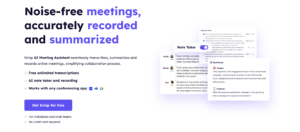Webinars are one of the powerful tools that help businesses connect with their audience in a meaningful way. They offer a platform for showcasing expertise, generating leads, and building relationships—all while delivering valuable insights. But to run a genuinely impactful webinar, you need more than just good content; you need strategic execution. This guide covers the most effective webinar best practices and tips. The latter help create engaging, high-performing webinars that resonate with your audience.
Why Are Webinars Important?
In 2024, webinars continue to be a preferred format for businesses aiming to engage their audience in real-time. According to a recent study, 76% of B2B buyers say they have attended a webinar in the past year, and 58% considered webinars the most valuable content source in their buying journey.
Webinars are not just about sharing information; they’re about connecting, interacting, and building trust.
Therefore, here are some critical use cases where webinars excel:
Educating and Training Employees
Webinars are widely used for internal training and upskilling employees. Companies can deliver consistent learning experiences across different locations, ensuring all team members receive the same information without the logistical challenges of in-person training. This is particularly effective for onboarding new hires, product training, and compliance updates, saving time and resources while enhancing learning retention.
Generating And Nurturing Leads
Webinars are powerful tools for attracting potential customers and nurturing existing leads. By providing valuable insights and solutions, companies can establish themselves as thought leaders in their industry. This helps build relationships and move prospects further down the sales funnel.
Engaging content, such as case studies, product demos, and expert discussions, encourages attendees to explore your offerings more deeply, often leading to higher conversion rates.
Demonstrating Products And Services
Product demos through webinars offer a live, interactive way to showcase the features and benefits of your offerings. Unlike pre-recorded videos, live demonstrations allow potential customers to ask questions in real time, providing immediate clarity and enhancing the buying decision process. This interactive element builds trust and helps address objections or queries that could hinder a sale.
Building Community And Engagement
Webinars are excellent platforms for building communities around your brand or industry. Hosting panel discussions, roundtables, or Q&A sessions with industry experts fosters a sense of belonging and positions your brand at the center of valuable conversations. This type of engagement helps deepen relationships, boost brand loyalty, and create a network of advocates who are likelier to promote your content and solutions.

Launching New Products or Features
Webinars provide a unique opportunity to create excitement and anticipation when launching a new product or feature. They allow companies to present their latest innovations directly to their target audience, providing a platform to highlight key benefits and gather instant feedback. This helps fine-tune the product and drives immediate engagement and potential early adopters.
How Long Should a Webinar Be?
A successful webinar usually runs between 45 to 60 minutes. This time frame is long enough to deliver substantial content but short enough to maintain attention. Structuring your webinar to keep discussions crisp and engaging helps prevent audience fatigue, ensuring they stay until the end.
However, you never know how engaged or disengaged an audience can be. A webinar can span longer and evoke meaningful discussions if the engagement levels are higher.
11 Best Practices For Webinars
Before diving into the details of how to run a successful webinar, let’s set the stage with the webinar best practices that can turn your next event into a standout experience. These practical webinar tips, drawn from industry-leading strategies, will help you design, promote, and deliver webinars that keep audiences coming back for more.
1. Understand Your Audience’s Pulse
To capture your audience’s interest, start by truly understanding who they are. Are they decision-makers, tech enthusiasts, or beginners in your field? Use surveys, feedback forms, and social media polls to gather insights. Knowing their preferences and pain points helps you tailor the content, making your webinar more relevant and engaging.
2. Define Clear Goals And Stick to Them
Every webinar should have a purpose, whether generating leads, educating clients, or positioning your brand as an industry leader. Setting clear goals keeps your content focused and drives your planning efforts. What do you want your attendees to learn, feel, or do after the webinar? Align your content to these objectives to ensure every minute adds value.
3. Select Topics That Spark Interest
Choosing the right topic is essential for drawing in your target audience. Consider what keeps them up at night—industry trends, common challenges, or new opportunities. Your topic should offer a unique perspective or solution that stands out. For example, instead of a broad subject like “Marketing Strategies,” narrow it down to something like “Using AI for Targeted B2B Campaigns” to appeal to a specific audience.
4. Secure Speakers Who Can Inspire
The right speakers elevate your webinar from good to great. Look for individuals who not only have expertise but also the charisma to keep audiences engaged. Whether it’s an industry thought leader, a customer with a success story, or an in-house expert, dynamic speakers who connect with attendees can significantly boost webinar engagement.
5. Create Engaging And Interactive Content
Webinars should be more than a one-way lecture. Incorporate interactive elements like live polls, Q&A sessions, and breakout rooms to make your session engaging. These interactions keep your audience active participants rather than passive listeners, improving their overall experience and retention of the material.
6. Promote Your Webinar Like an Event, Not a Task
Promoting a webinar requires more than just sending out a few emails. Develop a multi-channel webinar promotion best practices strategy, including email marketing, social media posts, and paid ads. Create a buzz by highlighting what makes your webinar special, and use compelling CTAs to drive registrations. Consider collaborating with influencers or partners to broaden your reach and attract more attendees.
7. Choose a Reliable Webinar Platform With All the Bells and Whistles
A smooth, user-friendly webinar platform is critical to a successful event. Choose technology that supports and improves your webinar experience rather than complicating it. Today’s audiences expect more than just a video call—they want an interactive, polished experience that keeps their attention and engagement high. Here’s where Krisp’s advanced features come into play, setting the stage for a flawless webinar.

The value of a webinar extends far beyond the live session, and with Krisp AI Meeting Assistant, you can maximize this potential. The real-time transcription meeting feature captures every word spoken during your webinar, turning it into an accessible, searchable text document. This makes it easier for attendees to revisit critical points, access information they might have missed, and even share insights with colleagues who couldn’t attend.
Transcriptions can also be repurposed into blog posts, whitepapers, or training materials, amplifying the reach of your content.
By automating this process with Krisp AI Note Taker, you save time and ensure accuracy, letting you focus on delivering a compelling webinar without the distraction of note-taking or worrying about missing key details. This feature bridges the gap between your live presentation and ongoing audience engagement.
8. Test, Tweak, and Rehearse
Preparation is key to avoiding the dreaded tech fails during your webinar. Run multiple tests of your audio, video, and internet connection before going live. A thorough rehearsal will also help you fine-tune your delivery, iron out any awkward transitions, and ensure that all interactive features function as planned.
9. Stay on Message And Keep It Concise
Webinars should be tight, focused, and valuable. Avoid going off on tangents or overloading your slides with text. Break down your content into manageable sections, using visuals, bullet points, and short anecdotes to keep the pace lively and the audience engaged. Remember, less is often more.
10. Follow Up: The Key to Turning Attendees Into Clients
The post-webinar phase is just as important as the event itself. Send personalized follow-up emails that include the webinar recording, key takeaways, and links to additional resources.

For high-value leads, consider offering exclusive follow-up sessions or consultations to keep the conversation going and drive conversions.
11. Evaluate And Optimize
Measure your success by analyzing key metrics such as registration numbers, attendance rates, and audience engagement. Post-webinar surveys can provide valuable feedback, highlighting what worked and what didn’t. Use these insights to refine and improve your future webinars.
What Are The Do’s And Don’ts of Webinars?
Creating a successful webinar involves understanding the essential do’s and don’ts that can significantly impact your event’s effectiveness. Let’s break down these webinar best practices to ensure your webinar delivers maximum value to your audience.
Webinar Best Practices—Do’s:
1. Engage Attendees With Interactive Features
Using interactive elements like polls, Q&A sessions, and chat rooms keeps your audience engaged and participants active. These features transform a standard webinar into an interactive experience, helping attendees feel involved and more connected to the content. By integrating real-time feedback tools, you can adjust your presentation on the fly to better meet attendee needs, boosting satisfaction and retention.
2. Test Your Technology to Avoid Glitches
Technical issues can derail even the most well-prepared webinars, leading to frustration and drop-offs. Conducting a full tech run-through before the event helps identify and resolve potential problems with audio, video, internet connectivity, and any interactive tools you plan to use. A smooth tech performance is crucial for maintaining a professional atmosphere and ensuring your audience remains focused on the content, not the glitches.
3. Deliver Valuable Content That Addresses Attendee Needs
Content is the heart of your webinar, so it must be relevant, insightful, and actionable. Tailor your content to solve specific problems or answer your audience’s questions. Using data, case studies, and practical examples can make your content more impactful. Remember, your goal is to leave attendees with clear takeaways they can apply immediately, making their time invested worthwhile.
Webinar Best Practices—Don’ts:
1. Avoid Turning Your Webinar Into a Sales Pitch
Audiences quickly lose interest when webinars feel more like infomercials than valuable learning experiences. Instead of focusing on selling, prioritize educating and providing genuine value. If your content addresses real challenges and offers actionable solutions, the sales naturally follow through with increased trust and interest in your product or service.
2. Don’t Overlook Post-Webinar Follow-Ups
The end of your webinar is just the beginning of deeper engagement. Failing to follow up with attendees means missing opportunities to nurture leads or solidify shared information. Send personalized follow-ups that include webinar recordings, additional resources, and invitations to future events. This keeps the conversation going and helps move attendees further down your conversion funnel.
3. Avoid Scheduling During Off-Peak Times; Consider Time Zones
Timing is everything when it comes to webinars. Hosting during off-peak hours or failing to account for different time zones can significantly reduce attendance. Research shows that mid-week webinars, especially around late mornings or early afternoons, tend to draw the highest turnout. Always plan your webinar to align with your audience’s most available and attentive times.
Webinar Promotion Best Practices
Effective promotion is the backbone of a successful webinar. Start early and maintain momentum by consistently reminding your audience of the value your event offers. Here are some quick and actionable webinar tips to ensure your promotional strategy hits the mark:
1. Craft a Captivating Webinar Landing Page
Your landing page is the gateway to your webinar and needs to capture attention quickly. Use a clear, benefit-driven headline and a concise description highlighting what attendees will learn.
Add engaging visuals, speaker bios, and easy-to-spot registration buttons. Incorporate social proof like testimonials or past attendee reviews to build trust and encourage sign-ups.

2. Use Email Campaigns With Personalized Outreach
Email marketing remains one of the most effective ways to reach your target audience. Segment your email lists based on interest, industry, or previous engagement to deliver personalized, resonating invites. Use compelling subject lines and highlight the unique takeaways of your webinar. Additionally, schedule reminder emails as the event approaches, including last-minute registration incentives or sneak peeks of the content.
3. Boost Engagement on Social Media
Social media is a powerful tool for driving awareness and engagement. Create a mix of posts, stories, and short videos on platforms like LinkedIn, Twitter, Facebook, and Instagram. Utilize countdowns, interactive polls, or behind-the-scenes looks to generate excitement. Don’t forget to use relevant hashtags and encourage your followers to share the event, expanding your reach organically.
4. Collaborate With Industry Experts And Influencers
Partnering with industry experts or influencers can significantly enhance your webinar’s credibility and reach. Invite them as guest speakers or co-hosts to tap into their established audience. These collaborations add authority to your event and attract attendees who value expert insights. Promote these partnerships in your marketing materials to boost attendance.
5. Use Paid Ads For Targeted Reach
Running paid ads on platforms like LinkedIn, Google, or Facebook can help target your ideal attendees. Tailor your ads to specific demographics, job roles, or industries to ensure they reach the right people. Use engaging visuals, clear CTAs, and concise copy emphasizing the value of attending your webinar. Track performance and adjust your strategy based on what resonates best with your audience.
Conclusion
Delivering a successful webinar goes beyond just presenting slides; it’s about creating a valuable, engaging experience that leaves a lasting impression. By following these webinar best practices, from knowing your audience to optimizing your follow-ups, you can transform your webinars into powerful tools for business growth.


